Madagascar, Past and Present: Biodiversity, Extinction & Conservation
About the Program |
Staff |
How to Apply |
Project Ideas |
Contact |
All students will be expected to complete a research project during their stay in Madagascar - this experiential learning is a central part of the experience, and many students go on to publish their results (click here for a list of published work). We’ve listed some suggestions for possible research project ideas below as possible starting points. However, you are encouraged to use your imagination and ingenuity! If you're interested in a project not listed here, don’t hesitate to contact the instructors as soon as possible to discuss alternate projects - some will be possible, others will not. You are highly encouraged to communicate with the instructors about your interests before leaving for Madagascar - some projects require certain advance preparation, but for almost any project it would benefit you to "hit the ground running".
1. Living Lemur Projects:
 |
1. Propithecus diademaThe diademed sifaka (Propithecus diadema) has been found to persist in medium-sized forest fragments (down to about 25 hectares), but shows signs of stress such as altered diet, reduced growth rate of juveniles and less energetic activity budgets. Projects in this area could include (1) feeding ecology, (2) ranging and habitat use, (3) social behavior, (4) scent-marking, (5) vocalizations, (6) positional behavior, (7) sex differences and feeding priority. Projects could involve following one or more study groups, depending on the comparisons required. Research to date has used focal animal follows for data collection, but new projects could use other techniques such as scan sampling or food patch sampling, or a new technique you devise yourself. All projects can capitalize on the five existing study groups in which all individual histories are known - this greatly expands the range of hypotheses students can test. |
 |
2. Hapalemur griseus and other bamboo lemursThe gentle bamboo lemur (Hapalemur griseus) is found in almost all forest fragments and appears to be resilient to habitat disturbance. It has a much smaller home range than sifakas, and some of its foods are relatively common, even in disturbed habitat. However, we still know very little about whether habitat alteration affects this species’ ecology – and the impact could be positive or negative (increased sunlight at fragment edges and light gaps often causes a surge in bamboo growth). Projects in this area could include (1) feeding ecology, (2) ranging and habitat use, (3) social behavior, (4) scent-marking, (5) vocalizations, (6) positional behaviour, (7) sex differences and feeding priority, etc. Currently there are two H. griseus study groups at Mahatsinjo – projects could involve one or both of these groups. The only research to date was two master’s degree project in 2011 and 2013. New projects could use additional techniques such as scan sampling or food patch sampling, or a new technique you devise yourself. In addition to H. griseus, research teams at Tsinjoarivo have recently documented the presence of the greater bamboo lemur (Prolemur simus). Another project could involve targeted searches for this critically endangered species, or detailed studies linking bamboo lemur species to the feeding traces they leave behind. |
 |
3. Lemur censusLine-transect censusing is a standard method for estimating local primate densities. It involves walking pre-established trails at a constant speed, recording all lemur sightings along the way. Data are analyzed by dividing the number of sightings by an estimate of the area sampled (using the data themselves to tell you how far to the left and right of the trail you are sampling). A lemur census conducted in 2001 in the Mahatsinjo region of Tsinjoarivo showed that many of the larger and more frugivorous lemurs had already gone extinct in small and medium-sized forest fragments. However, little is known about changes that have occurred since then. In addition, a 2012 field school census found a surprising lack of sportive lemurs (Lepilemur) which remains unexplained. Projects in this area could (1) re-census selected fragments to examine what changes in species incidence have happened in the past 12 years – have more species gone extinct, or have some species re-colonized “lost” fragments? (2) census new trails to test new questions – such as the relative lemur densities in edge vs. interior habitats, or ridgetops vs. valley bottoms, or disturbed vs. less-disturbed habitat. Another possibility could be nocturnal censusing. For example, there are two similar-sized nocturnal lemurs (Avahi and Lepilemur) both with a folivorous diet, and it would be interesting to know if they occupy different microhabitats. |
 |
4. Botanical censusPast botanical work has characterized the forest of the Mahatsinjo region in general, and the sifaka home ranges in particular. However, little is known about the plant species composition, structure, and temporal dynamics of forest edges, even though edge effects are likely having a huge impact on primate populations in this region. Projects could examine forest edges, looking at the effects of edge age, aspect, and local disturbance levels on the species composition, structure and/or temporal dynamics of forest edges. Are some “edge” species (may be natives, or exotics) invading forests through these edges? What lemur foods are more abundant, or less abundant, at edges? Students working on these projects would work with local research assistants familiar with botanical inventory techniques and species identification. |
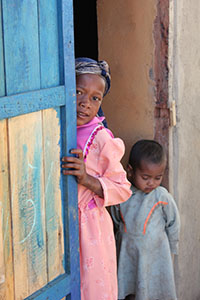 |
5. Communities and ConservationHaving not yet been included in Madagascar’s protected area system, biodiversity conservation at Tsinjoarivo depends largely on the will and participation of local people. SADABE works through local village associations to: (1) educate local people on local, regional and global environmental issues, (2) provide training and materials to jumpstart activities that promote wildlife conservation, and (3) provide support for local people to work in biodiversity research and conservation. However, much remains to be learned about the “right” ways to achieve conservation results in this landscape, and at any stage of the game, these desired outcomes can be jeopardized by failing to account for needs, desires, knowledge and opinions of local peoples. Projects in this area could use interview methods to gauge the functional and spiritual connections of local people with their forests, their knowledge of the flora and fauna, and their opinions of past, present and future “development” and “conservation” initiatives. Projects could explore ways to quantify shifts in perceptions and attitudes that have occurred since SADABE researchers started working at this site in 2001. This option would require prior approval since this is a study involving the use of human subjects. [Students interested in such projects should work with Dr. Irwin in advance to develop and submit a detailed proposal for institutional approval] |
 |
6. Seed dispersalSifakas are known to be seed predators rather than seed dispersers, but whole seeds are often found in the feces of older individuals who lack the masticatory ability to fully break apart its protective covering. There is still no full understanding of how these older adults could function as seed dispersers. Projects in this area could examine the dietary preferences of the old vs. young adults at Tsinjoarivo, and the examination of collected feces to quantify whether seeds or seed fragments are being passed. Do older animals show a preference for certain kinds of seeds? Is there a difference between ages in the types of foods consumed? Are some older dispersing seeds intact, or breaking them down less completely? Projects could also look at other lemur species. |
 |
7. Aye-aye distribution and ecologyAlthough it is difficult to track the nocturnal aye-aye (Daubentonia madagascariensis) in person, camera traps and distinctive foraging traces help researchers to identify the presence and predicted density of aye-aye in a particular forest. Aye-ayes have never been sighted by the research team at Tsinjoarivo, but their feeding traces have been detected in some of the studied forest fragments. Projects could involve far-ranging examination of the forests for recent aye-aye trace and the possible utilization of camera traps to help document the presence of these elusive nocturnal lemurs at Tsinjoarivo. This could help us learn more about whether aye-ayes are resilient in disturbed habitats, and also whether individual aye-ayes might be capable of crossing between forest fragments. |
 |
8. Camera trapsCamera traps allow the study of several ecological phenomena, and are especially useful for reclusive Aye-ayes, carnivores, and other nocturnal mammals. They can shed light on which species are present, their habits and habitat use, and even be used to study specific phenomena like geophagy. |
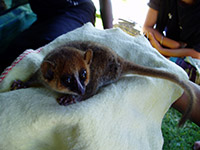 |
9. Mouse lemur dry season ecologyStudying mouse lemurs could involve a combination of nocturnal observation and trapping. Students could learn the protocols for trapping these small nocturnal primates, while testing certain hypotheses about their ecology. For example, one could test whether individuals trapped near fruit orchards have improved body condition relative to animals from the forest interior - thus examining how anthropogenic habitat change impacts this species' health, at least in the dry season. |
2. Extinct Lemur Projects:
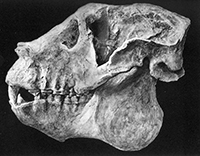 |
1. PaleoecologyPaleoecologists can glean important information about primate communities in the past by studying species compositions at fossil sites. The relative abundance of species with different resource needs or locomotor repertories could aid in the reconstruction of paleohabitats. At a more basic level, species presence or absence can be informative. In general, communities with a common biogeographic history will show a non-random, “nested” pattern of species composition. This means that communities with fewer species will tend to be nested subsets of communities with more species. Such a pattern is a predicted consequence of forest fragmentation; in other words, successive extinction of less tolerant species will create “nestedness.” In contrast, when species composition varies along a geographic or ecological gradient, nestedness will not exist. Instead, there may be a distance effect (with communities that are geographically close sharing more species). Exploring the pattern of species representation at fossil sites can yield insights into the history of forests in a particular area, allowing researchers to decipher past forest fragmentation. Students interested in paleoecological reconstruction could focus on the relative abundance of various species at a limited number of sites (MNI counts, derived by tallying, for any given skeletal element such as the humerus or femur, the number of lefts and rights at each site), or they could create presence/absence matrices for various species at a variety of sites. Comparisons can be made as well to communities in the present. |
 |
2. Butchery of Giant Lemurs / ForensicsThe importance of hunting or trapping of lemurs as a factor leading to their demise has been hotly debated. Recognizing signs of butchery (cut marks, chop marks) as opposed to scavenger chew marks or sedimentary scratches is essential if evidence of butchery of giant extinct lemurs is to be properly documented. Projects in this area could include the documentation of the distribution and pattern of scratches and breaks on the long bones of extinct lemurs. Students might pick a particular species, or a particular fossil site. They can document scratches, cuts and chop marks through photographs and making molds of potential surface features that can be later casted and examined under a microscope. The goal would be to distinguish human butchery from carnivore or scavenger damage, sedimentary marks, and trowel damage. Other forensics projects might also require prior training. Students with prior training in forensics might examine the bones of giant lemurs for evidence of pathology, healed breaks, or enamel hypoplasias in teeth, for example, which may provide some indirect evidence of stress of of activities. |
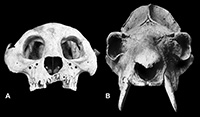 |
3. Body Size VariationDuring the Late Quaternary (in Madagascar and elsewhere), large-bodied species were more vulnerable to extinction than smaller-bodied species. Thus, understanding factors that influence body size variation is important. A rich literature explores factors influencing body size; researchers have proposed primary roles for temperature (Bergmann’s rule states that body size increases in cold environments), resource quality (large body size may be adaptive when resource quality is low); primary productivity and resource seasonality (body size may be constrained by the total availability of resources, or available energy; thus small size may be adaptive when resource energy is limited due to aridity, seasonality, or climate unpredictability). Projects could involve testing molar size differences of sister taxa (close relatives) living in cold vs. hot habitats, or habitats with high vs. low resource quality, high vs. low primary productivity, or high vs. low seasonality. |
|
4. Behavioral Reconstruction of Extinct SpeciesPaleontologists study skeletal morphology not merely to reconstruct evolutionary relationships, but to reconstruct the behavior of extinct vertebrate species (known only through skeletal remains). Specifically, paleontologists are interested in how skeletal morphology varies with variation in performance or behavior; this field is also called functional morphology. Projects in this area could focus on any selected form/function connection in an attempt to interpret the behavior of extinct lemur species. For example, to assess forelimb use in locomotion and specifically to reconstruct the degree of terrestrial quadrupedalism in extinct lemurs, students might measure the orientation of the medial epicondyle of the humerus (more terrestrial species tend to have more posteriorly reflected medial epicondyles). To assess the prevalence of leaping, students might measure the shape of the humeral and femoral midshafts (varies with force transmission), the shape of the distal femur, or the relative lengths of humeri and femora. To assess femoral excursion angles, they might measure the orientation of the ischium of the pelvis (species with more extended femoral excursion angles such as bipeds or vertical clingers and leapers tend to have relatively greater dorsal and relatively smaller distal lengths of the ischium). Measuring relative orbit size and the size of the optic canal might allow students to assess activity rhythm. |

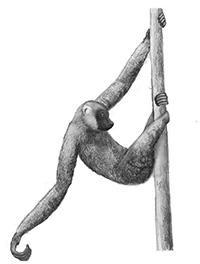 Image: B. Beaty
Image: B. Beaty